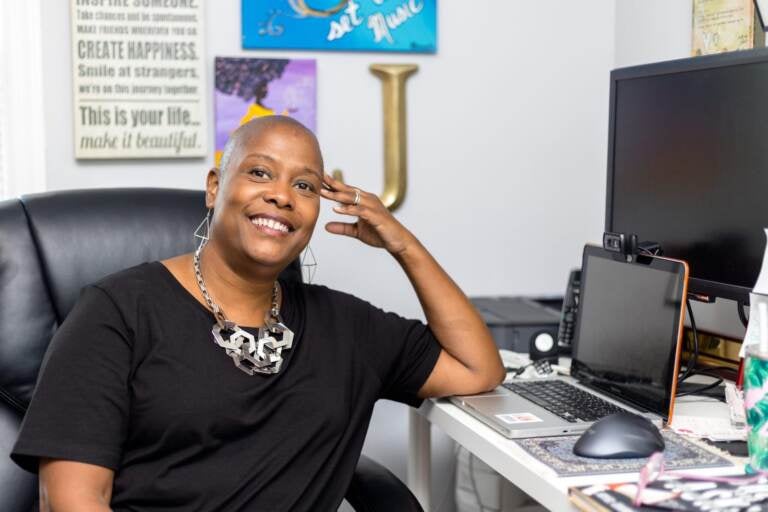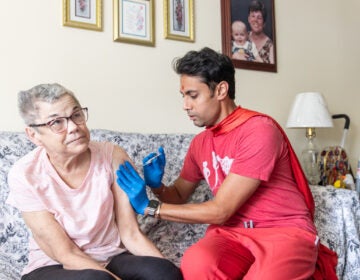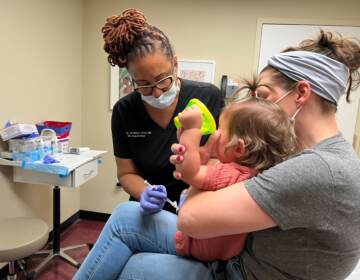Post-pandemic work includes wellness as a priority
Ten years ago, anxiety, sleeplessness, stress, and migraines came as Crawford worked her way up to management. But in 2020, she learned to work for herself in a pandemic.

A relaxed Joyel Crawford, 46, in her home office in Haddon Township, NJ. (Photo by Tezarah Wilkins)
This story originally appeared in Love Now Media.
The signs had been there before, but this time they appeared with a dose of irony. Joyel Crawford was a career coach suffering from career burnout.
Ten years ago, the anxiety and sleeplessness, stress and migraines, came while Crawford worked her way up from call center to management at Verizon. But last year, she was working for herself in the midst of a pandemic.
“Being a career coach was my life, my hustle, and in order to build my business up, I was running myself into the ground,” said Crawford, 46, of Haddon Township, NJ.
For Crawford, the pandemic – more than a year of isolation, death, and worry – led to a career reckoning, again. But this time, Crawford wasn’t just tempering the stress that comes with success. She was seeking a work-life balance that promoted her health and happiness.
The challenge emerged at a time when workers had begun reassessing their relationship to work. Employees have been quitting their jobs in record numbers, according to U.S. Bureau of Labor Statistics. In August, 4.3 million workers left their jobs in what has been called “The Great Resignation,” while some are redefining career satisfaction in what is being called “The Great Reset.” About 25 percent of workers in a May survey planned to look for a new position once the pandemic is “over,” according to a Prudential study about post-pandemic work and life. Nearly 50 percent of the survey’s respondents were rethinking their careers in search of a new job that offers higher pay, professional growth and a better work life balance.
As a certified coach, Crawford provides a service that helps clients figure out a career trajectory and go after it, but in a holistic way that also considers physical and emotional wellness. Stress management and mindfulness are key components of her coaching regimen.

Twice, Crawford had to learn to take her own advice.
In 1997, Crawford was climbing the career ladder at Verizon. She moved up from the call center to human resources, to training consultant, and finally to a management post in which she was responsible for the training and development of 30,000 employees.
“It was the best and worst experience of my life. I was doing what I loved — growing leaders and coaching people — but then things went sideways,” Crawford said. As her responsibilities multiplied, the boundaries between work and home eroded. She was juggling tasks constantly and sending emails at 3 a.m. She worked during vacations – on the rare occasion that she even took one.
The stress impacted her health. Crawford suffered from migraines. She gained and lost drastic amounts of weight. She developed insomnia, and when she fell asleep, she ground her teeth. One night, Crawford woke up and realized she was sitting up in bed with her fingers in a typing position on her pillow. Her husband was so concerned that he cut off the house Wi-Fi.
“Work consumed me. All I talked about was work. I was angry, crying and frustrated,” Crawford said..
In 2015, she resigned. Crawford used the time off to rest and redirect her career, focusing on the coaching she enjoyed so much at Verizon. She had started her own business, Crawford Leadership Strategies, in 2014. But it wasn’t until she left Verizon, that she focused on her business and it took off.
Geoff Irwin was one of the clients she coached. The Havertown resident had been looking to shift from software engineer to business consultant. His goal was to find a job advising companies about how to change practices, convince employees to buy in, and improve the bottom line. In preparation for the career switch, Irwin had expanded his skill set and earned a master’s degree.
Then the pandemic turned his home into a full-time office. Stress and anxiety ticked up. He was trying to solve serious technical problems for his company amid the distractions of a home life that included an energetic four year-old son.
“I did a lot of self-reflection about why I had the stress and was feeling the way I was,” said Irwin, 41.
His career coach faced the same challenge.
Early in the pandemic, Crawford’s work opportunities nearly vanished. The fear crept in that she wouldn’t have enough work to survive. So Crawford panicked. She began grabbing any training job she could find and private coaching sessions she could schedule. Before long, she found herself in a familiar place.
The migraines were back, along with vertigo and tinnitus. It was happening again. “I threw the taking care of myself to the wayside,” Crawford said.
Once again, Crawford decided to “slow down and heal.” She made self-care a part of her personal business plan, something she had coached her clients to do.
Crawford took a seven-week sabbatical. She hired an assistant, and found doctors that she trusted to help with the physical and emotional manifestations of her stress. She even wrote a book. Show Your Ask!: Using Your Voice to Advocate for Yourself and Your Career outlines strategies for readers and includes Crawford’s goal-setting methodology which can be used to ease on-the-job stress.
Crawford’s advice: Identify what you need. If you’re tired, sleep. If you’re anxious, take a moment to shake it out, talk it out. Then, make time in your schedule to create peace and “check yourself before you wreck yourself.” Finally, just do it. “Pray, meditate, take a bubble bath, or maybe a break from social media,” Crawford said.
Irwin, the Havertown consultant, dealt with it by taking walks. At first, he strolled around the neighborhood with his son, and then alone after the little boy went back to daycare.
“I was trying to take the opportunity to take care of myself more during the day. I feel like I came out of it as a better parent,” Irwin said. He also managed to secure a new job.
For Crawford, the pandemic helped her redefine success. Before COVID-19, winning professionally was about the accolades, awards, a full client load and a schedule packed from 9 to 5.
“But, I realized that success has to be more internal for me. It was about how I showed up and if I feel like I did the best I could,” Crawford said. Being not so ‘booked and busy’ is okay.
To stay on track, Crawford takes her own advice.
“I had to change my work and teach myself how not to work. People call it self-care. I call it self-leadership.”

Get daily updates from WHYY News!
WHYY is your source for fact-based, in-depth journalism and information. As a nonprofit organization, we rely on financial support from readers like you. Please give today.






